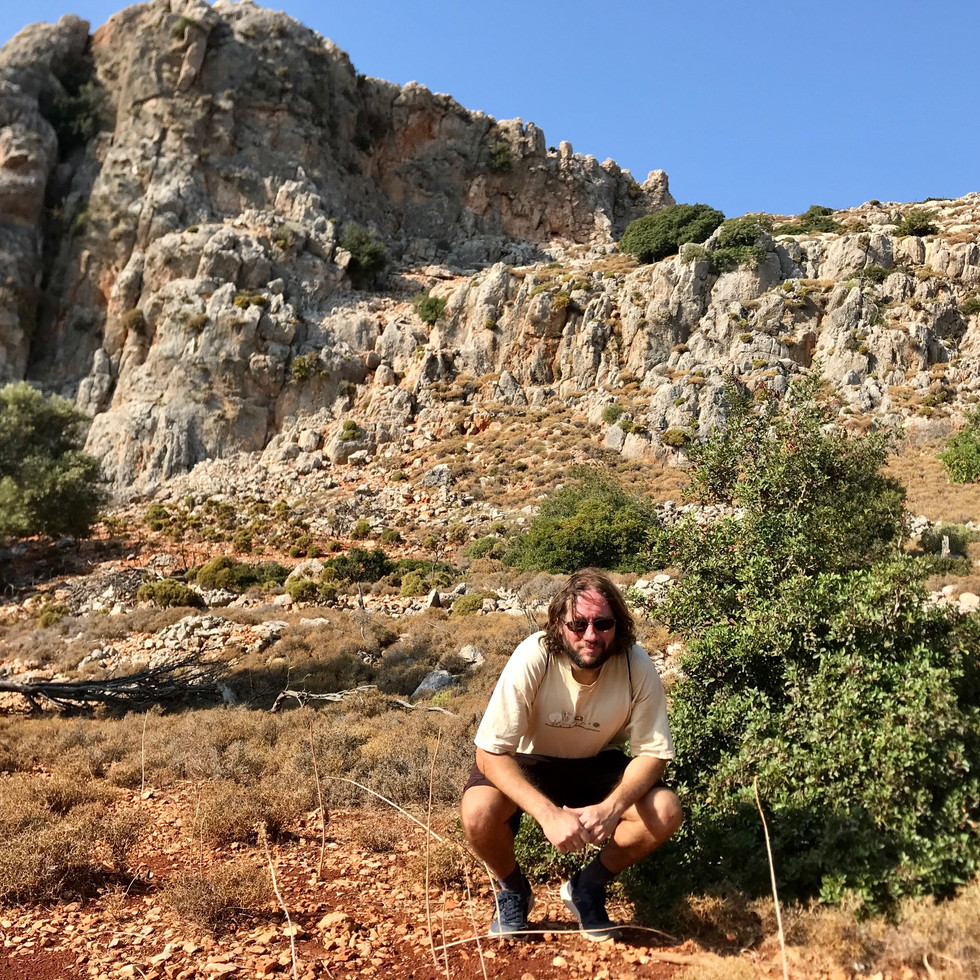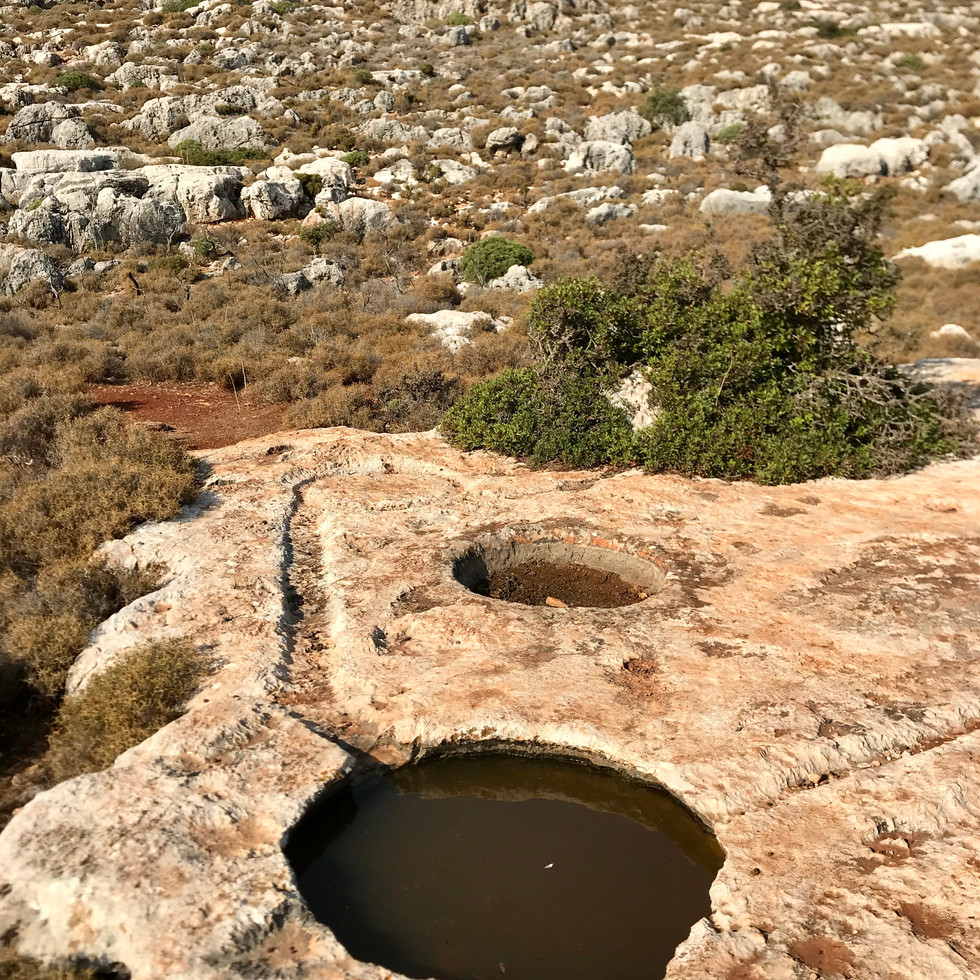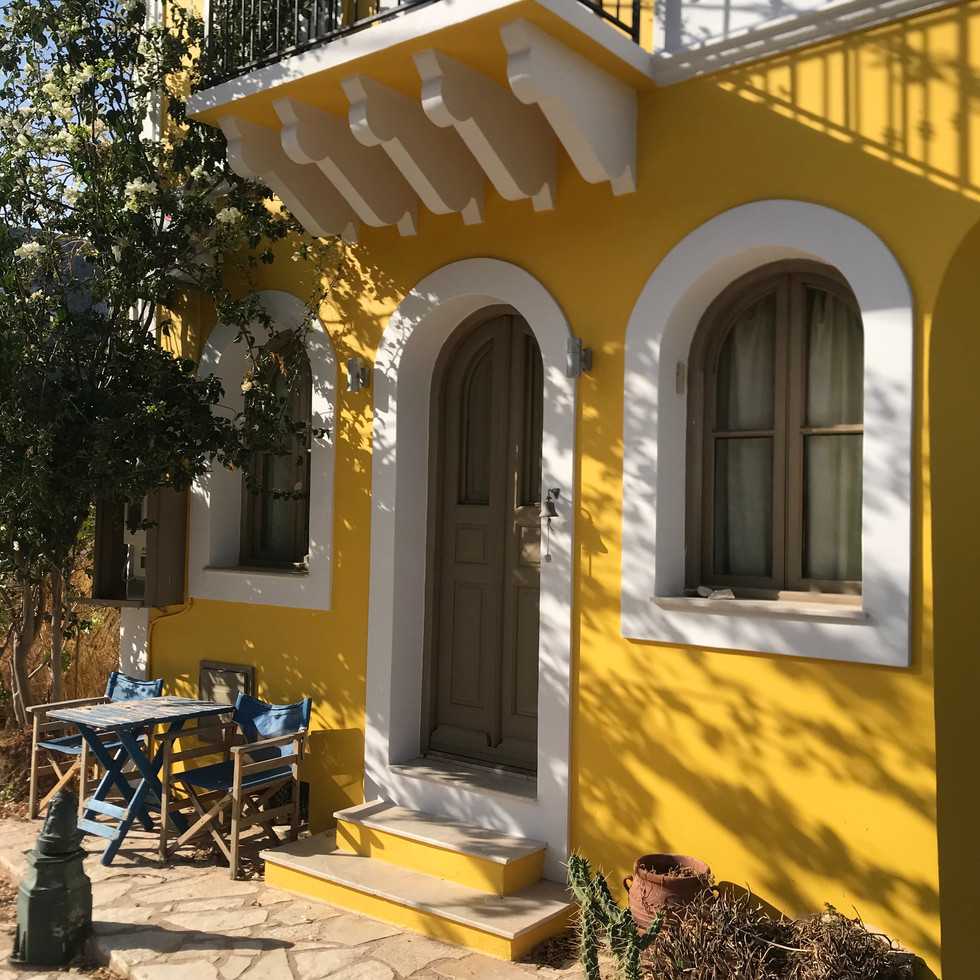Kastellorizo - island at the end of the Greek world
- Anna Kwiecinska
- Feb 17, 2022
- 13 min read
I began writing this as a letter to the participants on my last Sea to Sahara Tour of Morocco, after we spontaneously started chatting on our 'Whats App' group recently. Nostalgic for our travels and fantasising about getting together for another journey, many asked what I'd been doing since we parted company in Casablanca.
Above 3 pics: (1) The island of Kastellorizo (Greece) (2) The Hassan II Mosque in Casablanca (Morocco) overlooking the Atlantic ocean (3) Kastellorizo port
So emotionally transporting was this reminiscing, that for the first time since lockdown I was been blissfully unaware of the anxiety that curfew imposes.
Here's the letter I shared with this great group of travellers about my post-tour tour from the Western extremity of the Mediterranean to the Turkish coastline in the east ... the very area which Greece and Turkey now vigorously dispute.
Above 4 pics : 'Sea to Sahara' Travellers October 2019 : (1) In the Sahara; (2) with our friend Samir in Fes; (3) Getting familiar in Tangier; (4) Freezing in the High Atlas
LEAVING CASABLANCA
"I left not long after you all departed Casablanca, to visit an old friend in Greece, thinking I'd spend the languid month of November on the island of Hydra, taking it easy after a frenetic year of travel. I'd spent two years here in the early 90s, but since then, my friend had moved across the water to the town of Ermioni, a tiny village on an appendix of land opposite the island we had loved beyond words - yes, Hydra was still a uniquely vehicle-free place, but now fiercely expensive, because or despite, having been catapaulted by TripAdvisor into its list of 'Top Ten Things To Do in Greece'.
Above 5 pics: Ermioni is on the mainland of Peleponnese, in a tiny bay formed by a long isthmus - called 'Bisti' or 'tail' - with lovely swimming spots, reached from pine-scented paths. The island of Hydra, where I'd spent 2 years living in the 90s, is only 25 mins away by water taxi. (Map Wikipedia)
"As good as it was to catch up on island gossip and sleep in the same bed for more than 3 nights at a stretch, I was soon itchy footed. My heart could not yet contmplate a return to Hydra, filled, as it is, with emotional memories of almost unutterable nostalgia. So after a week of leisurely lunches and long walks on pine-scented pathways, Plan B effortlessly hatched, although it consisted of no more than booking a ticket to Athens and a cabin on a one-way ferry journey south.
FROM HYDRA TO ATHENS
The journey to Athens only takes 2 hrs by the hydroplanes known as Dolphins, but with 6 hours to fill-in before the ferry departed, I trundled my luggage to the Piraeus train station, bought a return ticket and made for the elegant leafy streets of Kolonaki behind the parliament square, to revisit my favourite of Athen's many excellent museums, the Benaki, with its exceptional collections of ancient textiles and jewllery.
above 7 pics: The finest extant examples of embroidery from the Dodecanese islands, where I was heading towards, are on display at the Benaki Museum. Breathtaking gold jewllery too.
Athens used to be a maddening city. Like Greece itself, it invoked a love-hate reaction which seemed to join us 'ex-pats' together in a shared predicament, as if we were somehow not here of our own volition. It was the place we loved, and loved to hate. We didn't want to be anywhere else, and this morning, Athens was absolutely where I wanted to be, and the Benaki's beautiful terrace restaurant was the perfect place to glimpse Athens' ladies who lunch.
By 2.30 pm I was back, boarding the ferry, and with a timeliness that perhaps in Greece only happens at sea, pulled out of port at precisely 3pm, the small brown smudge of Athenian air above the hill crowned by the improbably tiny Acropolis, receding slowly from view.
SAILING TO KASTELLORIZO
Once aboard, I was in a visible minority, the majority returning home to islands whose legendary names are the stuff of history. Inured to the natural beauty passing by outside, most settled into TV lounges for the long hours ahead, so I made for the linen-draped tables of the smallest restaurant on board, hoping this would be the quietest corner to idle before an early retreat. Although the eatery was about to close before re-opening for dinner at 7, the waiter generously indulged me a leisurely couple of hours to savour seafood risotto, a full-bodied Mani red, as sturdy as a Pugliese primitivo, and kindled our conversation by endlessly replenishing the crusty bread and peppery green olive oil.
I love tucking into bed aboard trains and boats. I even look forward to the shuddering night halts, and distant voices outside or below, as passengers and goods are shunted on and off the platform or the gangplank. To be honest, even the word 'gangplank' makes me excited at the thought of a journey ... so between naps in my comfy cabin, I was usually on deck to watch the nocturnal comings and goings as we docked into one Dodecanese island after another ... Kos, Kalymnos, Leros, Patmos, Lipsi, Symi, Karpathos ... each name for me now, framed by the dark outline of its port, with shapes to be filled in one day.
I even enjoyed the pre-dawn breakfast of too strong coffee and an oily tiropata, a triangle of feta cheese baked within layers of filo pasty hardened beneath all-night cafeteria lights, and now served listlessly by bleary-eyed waiters patiently attending to young mothers who needed bottles warmed. On the upper deck, I propped my feet against the rails and waited for Dawn's rosy fingers to extend across the churning wash and illuminate the scrubby silhouettes which hove in and out of view as we made our way to the South Eastern extremity of the Greek nation.
Above 4 pics: (1)The Dolphin pulling into the port of Ermioni at 7am on Day1. (2)The ferry from Piraeus to the islands. (3) and (4) best restaurant and cabin accommodation at the end of the Dodecanese archipelago, and finally disembarking 1pm on Day 2 at Kastellorizo. (map Wikipedia)
ARRVING AT KASTELLORIZO
Anyone left on board after Rhodes, the penultimate stop before our final destination, was disembarking at Kastellorizo, the smallest of the Dodecanese islands and the farthest east. On board now for almost 24 hours, we've travelled 570 Km southeast from Athens. There's a feverishness for land, and immediately the gangplank clanks open the few remaining passengers are quickly absorbed into the waiting crowd, which thins rapidly to be replaced by those gathering for the return journey.
I'd booked ahead for 3 nights and was met by my host at the boat. A man of few words, he hasn't offered to help with my luggage and I hurry to keep up as we wind in-between people sipping frappes at outdoor café tables, the narrow quayside never intended for anything wider than a heavily-laden donkey. After a few minutes, a small village square, the Plateia Ethelondon, opens out, along whose sides are a small supermarket, laudromat, public bathrooms, iron benches positioned to keep an eye on practically everything in the port, and a boat ticket office advertising reduced opening hours, and reduced boat departures. A good month after the end of the tourist season, many shops are already closed, Athenians packing up their summer houses, and the daily ferries were pared back to twice weekly.
Everything on the port was miniaturised by a massive, dark cliff face already blocking the sun, and bearing a giant Greek flag painted upon its limestone walls. Kastellorizo certainly seemed more than a little foreboding, but something about the paintbox colours of the tall, narrow houses with their distinctive wooden balconies still catching the sun farther along the port made me ask if my room was available for a week. Of course it was. So that was it then. I had a week to explore Kastellorizo.
4 photos: (1) Kastellorizo port lies in the shadow of a foreboding cliff face. It's only by late morning that the port is illuminated (2) the Greek flag adorns the cliff face which dominates the town (3) The Palace of the Hospitaller Knights of Rhodes, 1306, is generally considered to give its name to the island - meaning 'red castle' - although there are other explanations (4) The crennellated walls of the red castle.
The 24/7 presence of the Greek navy vessel in the foreground is a constant reminder of the tensions with Turkey, just 5 km away. What you can't see here is the military installation over the ridge, where soldiers and equipment are stationed ready to spring into action at the slightest provocation.
My room was reached by a steep climb up a creaking narrow staircase to the top floor of a restored stone building, with spectacular views to the cliffs and port. Every hard surface was painted in glossy blue enamels, with white, hand-made lace covering the bed and softening the edges of the turquoise window sashes. A time-worn rug of old rose colours made it snug. It was pretty and Spartan at once - nothing superfluous and neat as a pin. Placing the ceramic jug I'd bought at the Benaki Museum giftshop on a lacy doily, I went off in search of lunch and flowers.
Above 4 pics: (1) the port's narrow quayside bounded by buildings that served as warehouses in the island's late C.19th heyday when it served as a shipping emporium between Anatolia, Egypt and Rhodes. (2 and 3) cobblestoned alleys get very slippery with the salty a lead to my guest house, most houses deserted now for the winter (4) Octopus salad - delicious until one sees an octopus actually being clobbered to death
It's easy for lunch to become dinner at this time of the year when days darken by 5.30pm, and my desire to fit as much as possible into each day seemed at odds with the incredibly relaxed atmosphere which pervaded the small village.
Late Autumnal sun, gentle and brief, telescoped any desire to swim into a 3-hour window from midday. On a port still shadowed by 10am, and the choice of tavernas narrowing daily as one after another drew shutters and boarded up the doors ‘til Easter, breakfast is late and leisurely before a walk to the end of the port. Ducking beneath a fence and scrabbling over rocks to reach the spot where the locals dip, the cool, clear water quickly deepens to sapphire blue, barely fringed by shallows, and suddenly, eerily dark when the sun slips behind a cloud. Sunbathing is a feat of endurance amongst these rocks, squirming for comfort and warmth as the sun makes its way over the dark hills behind the port. Eventually I feel faintly ridiculous sitting alone on a barely-beach, eeking out the last of the day already at 3pm, and wander back for another coffee before darkness quickly falls and the soldiers who maintain a 24/7 presence over the ridge come and take all the tables. There are so many reminders that Turkey sits just 2 km away and stares back at Kastellorizo over visibly militarised waters.

(above) Although summer tourists will hire boats to take them to blue grottoes and other pretty turquoise bays, the locals dip at the end of the port, near a white building which served as a warehouse for sponges, one of the island's lucrative industries.
THE KASTELLORIZANS
It is no exaggeration to say that the islanders are not an overly friendly lot. Exhausted by the fag end of summer, money made to last the winter and, for those who run boutiques, a long stint in Bali or Thailand ahead to replenish stock for the next season, they’re not especially conversational. No one cares where I’m from. I remember this self-isolation from my 2 years on Hydra. Tourists come, spend, go. Those who show signs of lingering must prove themselves with weeks, if not months, of self-sufficient presence before anyone permanent will even register one’s existence. With any luck, an invitation to Paska, Greek Easter, several months ahead, might be the reward for months of politely-nodding persistence.
Eventually this changes, and one can spend years living in a community, possibly as part of it, but often not, on first name terms with people whose surnames will never be known, defined instead by their occupation - 'Dmitri the donkey man' … people who will do anything for you – eventually.
It is this very internal cohesiveness which defines islanders. Identity remains, regardless of rulers - and none more so than Kastellorizo, whose fortunes have swung wildly since Dorian times, (C.5th BC), when it was first called by its formal name 'Megisti'. Centuries of colonisation and domination by Ottomans, Franks, Italians, even the Knights Hospitaller in the C1.4th, who had made Rhodes their seat of power, have forged a fiercely Kastellorizo-centric mindset.
By the time I arrived, foreigners had all but gone, if we don't count the rather well-dressed Syrian refugees camping in the forests. I was content to set off on day-long walks alone, picking up a picnic of cheese pie and cinnamon cookies from the only bakery still open, and carrying water, as there was absolutely nothing available beyond the thin crescent of the port. It was a week of unlonely solitude, but the desire for conversation can either be a bonus or a burden when travelling alone. Perhaps it was no coincidence that I was to meet two of the island's more unusual residents.
THE SCULPTOR
Swimming beyond my comfort zone on a sunny day when the depths seemed less threatening, a tall, wiry-limbed man with long grey beard waved lazily from the shore where he stood at the arched doorway of a white-washed building not much taller than himself. I waved back and swam to the steps where he stood.
"Would you like a coffee?"
The small stone, barrel-vaulted building at the far entrance to the port had been a warehouse when Kastellorizo was a thriving emporium at the shipping crossroads of Anatolia, Egypt and Rhodes, and for the last 40 summers this wild-haired character had set about sculpting the surrounding terrain into a sort of Socratic garden. Reclusive and scathing of the locals, he reluctantly came into port for supplies, barefoot and biblical-looking, and spent most of his time excavating his damp abode by lantern light, carving the stony outcrops within into an enduring work of art. That this Spartan bedsit, the kind where every object has a little nail upon which to hang, has claimed more than half a lifetime of summers endeared him to me enormously, and over coffees made on a primus stove propped up with books, I learnt that his native land was another harsh and rugged region - hills of Thessaly, at the other end of the nation. I wondered what he did there all winter.
above: Th artist who has spent his last 40 summers on Kastellorizo, sculpting the rocky surrounds of his studio into a kind of Socratic garden, Alexandros Zagoras hails from Thessaly in the far north of the Greek mainland
THE PUZZLE INVENTOR
I met a puzzle-inventor who was searching for, and mapping, ancient sites on the island. Glad of the company, he invited me to accompany him on energetic walks across scrubby westward-facing hills. He showed me wine presses carved into limestone outcrops, Mycenean walls, barely documented - who thought their civilisation stretched so far south?, rock-cut tombs, even.
Above 5 pics : (1) The puzzle inventor who sends his spare time discovering and mapping ancient ruins and sites (2) a wine press carved into limestone uses gravity to do the decanting (3) limestone wine press (4) Mycenean ruins (5) rock-cut tombs
KASTELLORIZO'S FORTUNES
Kastellorizo's prosperity finally came to a dramatic end when an Allied ammunitions site exploded in 1944 destroying almost half the island's houses, which had numbered around 10,000 in 1900. Thus, the final blow to an already dwindling population forced the majority into a diaspora whose identity remains forged amongst this harsh landscape, and now counts Perth and Sydney as major centres of 'Kazzie' culture. Those that remain "wouldn't live anywhere else".

Above: You'll have to pass Maria's house on the Plataeia Ethelondon to reach the only bakery open during the off-season. A vigorous sweeper of public spaces, she laments the 'nuisance' of refugees who don't bother with the rubbish bins
And the children of those that left are starting to return. Many of the stone ruins that cover the hillside above the C.18th Ottoman mosque (now a museum), which sits on the promontory opposite Alex's studio across the bay, display the names of new owners. Defiantly spray-painted to deter the likes of holiday-makers heading for the real estate brokers, they promise, or threaten, years of expensive restoration, for stone masonry is seasonal work requiring teams of craftsmen and labourers, often sourced from the Turkish coastal towns where many islanders shop for cheaper groceries and produce.
I'll admit that the lure of restoring a ruin to life here is a bit irresistible. Kastllorizo's architecture, defined by tall, slender 2 or 3-storey homes with wooden balconies are a decorator's dream of riotous colours, their striking individuality almost a metaphor for the islanders themselves.
Above : (1) ruinous properties sold to younger generations of 'Kazzie' families (2+) the
undeniable pleasure of contemplating a colour scheme for your new island holiday home.
On Sunday morning I set off for the Church of St Constantine and Helena in the slightly elevated suburb of Horafia. Along the way, small brass cups of smoking frankincense set on walls waft fragrant tendrils laced with the zing of fresh basil, a contrast to the church interior, all waxy polish and smelling of disuse.
No one was particularly surprised as I took a seat in the high stalls which lined the sides of the gilded interior, women to the left, men to the right, and followed their actions of standing and sitting as the priest went through his sung liturgy. The women numbered less than ten and stayed for the entire service, whilst the few men turned up towards the end of the service, paid their respects at the icons whom most leant to kiss, and left. Two male singers of fine voice sang back and forth in the dramatic way of Orthodox services, and happily received my compliments when we found ourselves breakfasting together in the port later, the priest now enjoying a cigarette and thoroughly preoccupied with his daughter and grandchildren.
Above: Sunday mornings make for a fragrant time to wander the streets of Kastellorizo as smoking frankincense and springs of basil scent the pathways.
HORAFIA and MANDRAKI BAY
Horafia, and its small adjoining port of Mandraki, offer another dimension to living on Kastellorizo. Majestic views across the languid stretch of water separating Greece from its nemesis, Turkey, are wistfully shadowed in the Autumn afternoon. The water laps so quietly at the sandy shore that I can just make out the evening call to prayer from the mosque on the mainland.

Above; with the shires of turkey sunlit in the distance, Horafia and its mooring area of Mandraki Bay offer a more languid ambience than the commercial centre of the port.
Here, where cultures meet, and at times have coalesced, the panorama of a vast history is pulled into focus. How much this tiny island, no more than 11 sq.km in area, has suffered, prospered, laboured and sparkled, with at least two and a half thousand years of habitation.
That it now draws its far-flung families back to retrace family histories seems only natural - indeed I have come here precisely because the only friend I'm still in contact with since primary school has spoken its name since childhood. Her mother taught me to crochet.
I am sure I will return. Greece has that way - even when one is not of its shores.

The only cemetery at the water's edge near Horafia offers a poignant snapshot into the island's recent history.
Anna travelled to Greece for the entire month of November in 2019, staying for 7 nights on Kastellorizo, before taking a ferry to Rhodes, 143 km north.
This is my final vista of Kastellorizo, with the cupolas of St Constantine and Helena on the distant left, the very steep path to the ridge in the top right corner, and the rocky terrain with the ancient winepresses over the edge of that ridge.
My guest house is located to the right of this picture, in the centre of the port, and the swimming spot is to the far right, whilst the old mosque is to the far left. The castle dominates the town just out of picture to the lefthand side forground.

All photos in this story are Copyright, by the author, except for the maps (Wikipedia) and the group photos taken on the Sea to Sahara tour in Morocco.
Thank you for reading, I hope you enjoyed the story - do please share!
and now you leave me a comment below (just keep scrolling down a bit ) - I'd love to hear from you - and I'll be sure to get back to you,
Cheerio
Anna














































































































Comentários